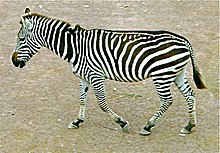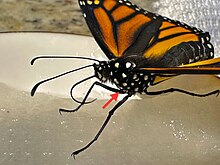Quadrupedalism is a form of locomotion where animals have four legs that are used to bear weight and move around. An animal or machine that usually maintains a four-legged posture and moves using all four legs is said to be a quadruped (from Latin quattuor for "four", and pes, pedis for "foot"). Quadruped animals are found among both vertebrates and invertebrates.


Quadrupeds vs. tetrapods
editAlthough the words ‘quadruped’ and ‘tetrapod’ are both derived from terms meaning ‘four-footed’, they have distinct meanings. A tetrapod is any member of the taxonomic unit Tetrapoda (which is defined by descent from a specific four-limbed ancestor), whereas a quadruped actually uses four limbs for locomotion. Not all tetrapods are quadrupeds and not all entities that could be described as ‘quadrupedal’ are tetrapods. This last meaning includes certain artificial objects; almost all quadruped organisms are tetrapods (one exception is some raptorial arthropods adapted for four-footed locomotion, such as the Mantodea. Another example is brush-footed butterflies (Nymphalidae), the largest butterfly family with ~6000 species, including the well-known monarch (shown in photo)).
The distinction between quadrupeds and tetrapods is important in evolutionary biology, particularly in the context of tetrapods whose limbs have adapted to other roles (e.g., hands in the case of humans, wings in the case of birds and bats, and fins in the case of whales). All of these animals are tetrapods, but not all are quadrupeds. Even snakes, whose limbs have become vestigial or lost entirely, are, nevertheless, tetrapods.
In infants and for exercise
editQuadrupedalism is sometimes referred to as being "on all fours", and is observed in crawling, especially by infants.[1]
In the 20th century quadrupedal movement was popularized as a form of physical exercise by Georges Hebert.[2] Kenichi Ito is a Japanese man famous for speed running on four limbs in competitions.[3]
Other human quadrupedalism
editIn July 2005, in rural Turkey, scientists discovered five Turkish siblings who had learned to walk naturally on their hands and feet. Unlike chimpanzees, which ambulate on their knuckles, the Ulas family walked on their palms, allowing them to preserve the dexterity of their fingers.[4][5][6]
Quadrupedal robots
editBigDog is a dynamically stable quadruped robot created in 2005 by Boston Dynamics with Foster-Miller, the NASA Jet Propulsion Laboratory, and the Harvard University Concord Field Station.[7] Its successor was Spot.
Also by NASA JPL, in collaboration with University of California, Santa Barbara Robotics Lab, is RoboSimian, with emphasis on stability and deliberation. It has been demonstrated at the DARPA Robotics Challenge.[8]
Pronograde posture
editA related concept to quadrupedalism is pronogrady, or having a horizontal posture of the trunk. Although nearly all quadrupedal animals are pronograde, bipedal animals also have that posture, including many living birds and extinct dinosaurs.[9]
Nonhuman apes with orthograde (vertical) backs may walk quadrupedally in what is called knuckle-walking.[10]
See also
editReferences
edit- ^ Mondschein, Emily R., Karen E. Adolph, and Catherine S. Tamis-LeMonda. "Gender bias in mothers' expectations about infant crawling." Journal of experimental child psychology 77.4 (2000): 304–316.
- ^ Rathbone, Keith (8 February 2022). Sport and physical culture in Occupied France: Authoritarianism, agency, and everyday life. Manchester University Press. p. 73. ISBN 978-1-5261-5327-2.
- ^ Swatman, Rachel (12 November 2015). "Video: Watch Japan's Kenichi Ito scamper to GWR Day success with fastest 100 m running on all fours". Guinness World Records. Tokyo. Archived from the original on 16 November 2015.
- ^ "Family Walks on All Fours, May Offer Evolution Insight, Experts Say". National Geographic. 8 March 2006. Archived from the original on 24 May 2016.
- ^ "Science May Finally Explain Why This Family Walks On All Fours". Huffingtonposts. 17 July 2014. Archived from the original on 9 May 2016.
- ^ Türkmen S, Demirhan O, Hoffmann K, et al. (May 2006). "Cerebellar hypoplasia and quadrupedal locomotion in humans as a recessive trait mapping to chromosome 17p". J. Med. Genet. 43 (5): 461–4. doi:10.1136/jmg.2005.040030. PMC 2564522. PMID 16371500.
- ^ "BigDog - The Most Advanced Rough-Terrain Robot on Earth". Boston Dynamics. Archived from the original on 2011-04-23. Retrieved 2011-04-06.
- ^ "DARPA Robotics Challenge, RoboSimian (Track A)". JPL Robotics. Archived from the original on 2016-03-07. Retrieved 2016-03-07.
- ^ Andrada, Emanuel; Rode, Christian; Sutedja, Yefta; Nyakatura, John A.; Blickhan, Reinhard (2014-12-22). "Trunk orientation causes asymmetries in leg function in small bird terrestrial locomotion". Proceedings of the Royal Society B: Biological Sciences. 281 (1797): 20141405. doi:10.1098/rspb.2014.1405. PMC 4240980. PMID 25377449.
- ^ Gebo, Daniel L. (2013). "Primate Locomotion". Nature Education Knowledge. 4 (8): 1.